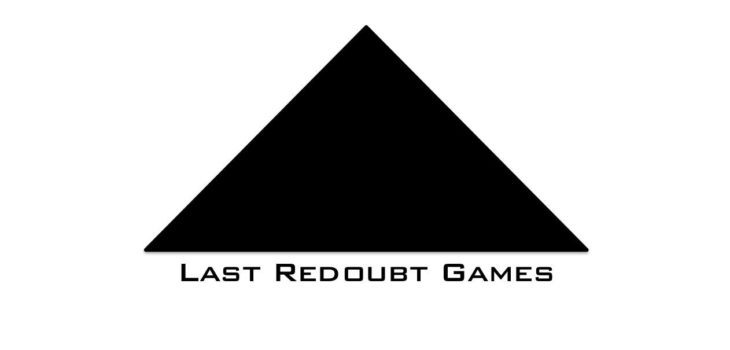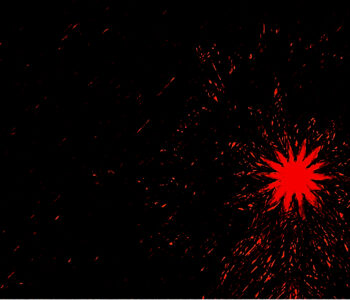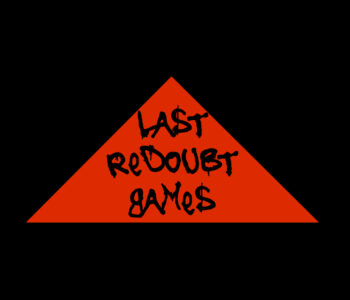 News & Updates
News & Updates
The Long Road to the Last Redoubt
So, Last Redoubt Games…
Maybe it’s best to start at the beginning. I’ve been playing roleplaying games for over twenty years, going back to the time I somehow convinced my mother to buy me a copy of the Dungeons & Dragons “Red Box” starter set (the Mentzer version with the sweet Larry Elmore cover) at a yard sale. I must have been eleven or twelve at the time. That box set included a single-player starter adventure that introduced you to some of the basic elements of the game and then provided a basic starting adventure for a multiplayer game run by a game master (or, in D&D lingo, a Dungeon Master). Since I was an only child living outside of town, I didn’t have a group of friends at the ready to play, so the game kind of collected dust on my shelf after I played through the initial adventure.
My real introduction into roleplaying came when a guy in my marching band squad in the ninth grade turned to me and asked me if I’d heard of a game called Shadowrun. I was, in fact, familiar with the game because I knew about the recently released Super Nintendo game that was based upon it. He and a friend of his had recently ordered a copy of the Shadowrun rulebook and suggested that I join them for a game session when it arrived. We got together with yet another friend to play a game called Underground, which was kind of a bonkers sci-fi dystopia where the players are down on their luck mutant war veterans making a living on the mean streets of a cynical post-capitalist society (think First Blood crossed with Taxi Driver crossed with Blade Runner crossed with Total Recall). It was a weird game session that saw my character literally blown to bits in the first ten minutes (and carried to the hospital in a beer mug and a used condom), but I had a blast and I’ve pretty much been hooked ever since. In addition to playing Shadowrun, I ordered Earthdawn, the recently released fantasy game from the same publisher (FASA Corporation). My high school gaming group changed composition a bit throughout the years, but we played a lot of Earthdawn. Even when I moved to another state while I was in college, a few of us would still play every time we got together (Sadly, we took a hiatus from Earthdawn a few years ago, but that’s a rather sensitive subject for another post).
That’s all a long way of saying that I’ve always been drawn to roleplaying games. Almost from the very beginning, I was the person in my group running games and coming up with adventures. In high school, my dream job was to be a writer and game developer for FASA or White Wolf Publishing (who at that time published the World of Darkness game line). By my first year of college, I was devoting a lot of thought to creating roleplaying game settings, fleshing out entire worlds that could be used as the basis for entire game lines. Much of this was a byproduct of the era. Roleplaying games in the 1990s focused HEAVILY upon setting and story. Even D&D was featuring game lines like Dark Sun and Planescape, which established evocative new worlds with intricate storylines that were advanced little by little with the release of each adventure module. I played a lot of FASA games in those days, so I got a hefty helping of this style of game development from Shadowrun, Earthdawn, and Battletech. I had more setting material for Shadowrun and Earthdawn than I could ever hope to use in a single campaign, but I couldn’t get enough of those worlds.
My first game I tried to develop was…um…bad. Known at various points by the awful title “SoulQuest” and name of the setting, “Ranchess,” this game was…well…an attempt at something. All kidding aside, the setting was important for my development as a writer because it was the first thing I actually tried to use as the basis for a novel. I still have a crate of notebooks somewhere in my house with the first thirty or forty thousand handwritten words of this first attempt (Bits and pieces of it have actually survived to live again in other projects, some of which might yet see the light of day). As a game, though, it sucked. I don’t remember how much of a rules system I had sketched out, but I quickly abandoned the idea for another game that I started working on in the early 2000s. That game, Dark Earth, actually got quite far along. I had a prototype rules document, complete with various races, classes, and abilities written out in rather exacting detail. Since I didn’t have a gaming group at the time, playtesting never got off the ground and I eventually decided that the rules were too similar to other things I’d seen anyway (there was an attempt to convert it to a d20 system at one point as well).
A little over ten years ago, I wrote a short story called “La Tierra de la Sangre,” which features a magical, swords & sorcery alternate history of the Caribbean in the Age of Piracy. Partially inspired by the Pirates of the Caribbean movies, I envisioned a setting that drew heavily upon both actual history and a madcap mashup of historical “could have beens” such as the Chinese continuing to establish naval dominance in the Indian and Pacific Oceans, the Vikings gaining a firm foothold in northeastern Canada, the Aztecs repelling the Spanish with massive stone warships powered by blood sacrifice, and so on. I thought the setting was a natural fit for a roleplaying game, so I set about developing a rule system I thought was pretty unique. The resulting game, Crimson Seas, felt like it fit a niche I hadn’t really seen filled and I had high hopes for publishing it in some form as digital publishing for rpgs had become so much easier by the early 2010s.
Last Redoubt Games was the name I came up with for this publishing venture that never got off the ground. The name itself is a reference to “The Last Redoubt,” the foreboding pyramid fortress featured prominently in William Hope Hodgson’s brilliant but obtuse 1912 novel The Night Land. Unfortunately, Crimson Seas didn’t withstand the rigors of my own close scrutiny, much less playtesting. By the time the game got to a playable state around 2014 or 2015, I’d started gaming more frequently and I came to see that Crimson Seas wasn’t quite as groundbreaking or as interesting as I’d thought. Even worse, the more I worked on it, the more it started to resemble the types of games I didn’t particularly like in the first place. I eventually scrapped everything and laid out a plan to totally redesign the game.
But I never got around to it.
Sometimes you work on something for so long that you just can’t go back to it again. Maybe I got burned out or maybe I came around to the idea that the concept itself wasn’t all that great. I don’t know, but for whatever reason, I never went back to rework the game into something usable. In the meantime, though, I started developing a few new ideas into fully-fledged game concepts. One of them was inspired by the video game Helldivers, which my son and I became obsessed with about two years ago. For those unfamiliar with the game, it’s essentially Starship Troopers, with the players in the role of elite soldiers being dropped down to a planet to perform some super dangerous mission deep in enemy territory. For my son’s birthday party, I thought it would be fun to make a tabletop miniatures game version of Helldivers for him and his friends to play. We didn’t get around to playing it, so the idea sat in a notebook until last year when I started tinkering with it again. This time, however, I actually got a group of people to sit down and play it. This kicked off a playtesting process that saw the game, now called Archangels, change dramatically. The first major change was the elimination of a gamemaster player. Originally, Archangels required one player to control enemy units. In the latest version, enemy actions are totally automated by way of a card system, so every player can concentrate on strategy and coordination with their teammates rather than bookkeeping enemy stats. While it still needs a bit more refining, Archangels is feeling more and more like a finished game and I’m starting to let myself think about things like researching how to produce game components, how to organize a Kickstarter, how to commission artwork, and how to do graphic design. It’s a daunting but exciting prospect.
Since Archangels is a bit of a complicated project, I thought it would be a good idea to put together something simpler that would help me establish an identity for Last Redoubt Games. My taste in roleplaying games has changed dramatically from when I was younger and had more time on my hands. While I used to enjoy books that gave you page after page after page of rules, character options, and setting detail, today I appreciate games that are simple, flexible, and to the point. A book like Dragon Age from Green Ronin Publishing is fantastic and I love it, but sometimes I want the simplicity of Lamentations of the Flame Princess, which provides no specific setting material and a very simple set of rules. The two games that have had the biggest influence on me in this regard are Into the Odd by Chris McDowall and Ghost/Echo by John Harper, which focus heavily on getting into the game as quickly as possible and not getting bogged down by requiring players to master extensive rules mechanics to get the most out of a game.
The result of all this brainstorming is a game called Hounds of the Tsar. Based on an idea for a Lamentations of the Flame Princess game I never got around to running, the game sees the players take on the role of Oprichniks, who were ostensibly the secret police force for the Ivan the Terrible in late 1560s Russia. While I intend to run a number of playtests myself, I decided to make the prototype version of the game available for anyone who wants to give it a try. The draft document is only about fifteen pages long and provides enough information to get a basic campaign off the ground, but gamemasters and players will have to fill in some gaps if they want to stretch things beyond a few adventures. Some of those omissions are intentional. I want the game to be open-ended enough for groups to create their own unique material. Too often roleplaying games condition players to do everything strictly “by the book” and they become hesitant to make up their own rules when the situation might demand it. While Hounds of the Tsar will almost certainly add more material to provide players with a toolbox for incorporating their own ideas into the game, I don’t anticipate adding much in the way of specific rules or content. For the time being, the game is what it is, and I’d need to have some pretty compelling and overwhelming feedback to make me want to change that.
You can view and download a PDF copy of Hounds of the Tsar here. Read it, play it, and let me know what you think. I’ll have a little more to say about it in the coming weeks, so keep checking in here or the Last Redoubt Facebook page for updates if you’re interested in how this little project pans out.










